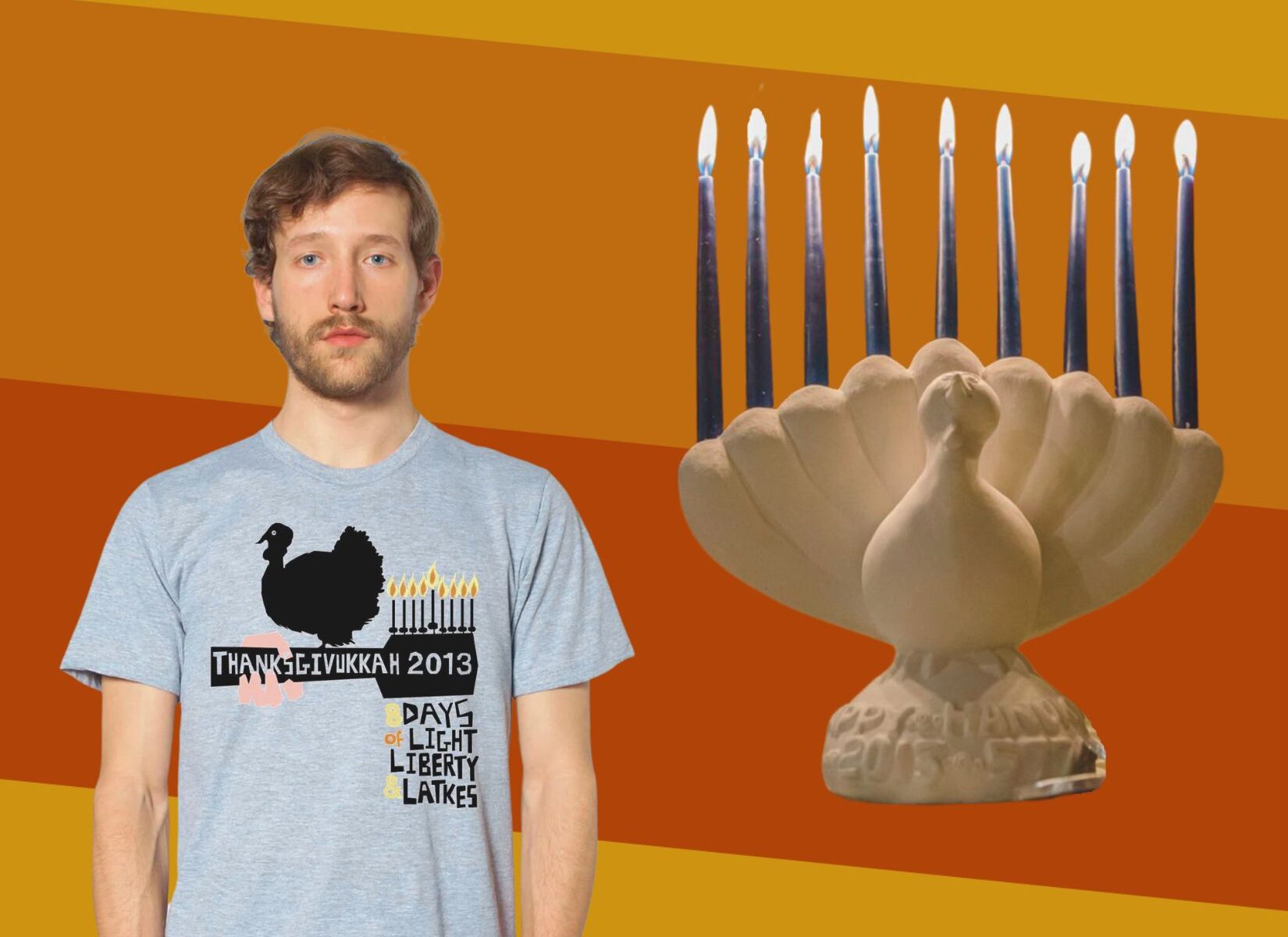(JTA) — It’s been 10 years since Thanksgivukkah — the rare convergence of Thanksgiving and Hanukkah — revolutionized the Jewish-American holiday experience.
It’s amazing that just one decade ago the biggest slogan in our community was “Light, Liberty and Latkes.” In these dark and difficult times, that phrase can call us back to a simpler, less threatening era in American Jewish history — and it can also remind us to imagine a more hopeful future.
Thanksgivukkah itself was a calendar rarity that won’t happen again for another 80,000 years. Turning the coincidence into a communal event was the brainchild of Dana Reichman Gitell, a marketing professional living in the Greater Boston area. Her lighthearted idea for a holiday mashup became a Jewish-American merchandising, culinary and even spiritual bonanza.
Back in 2013, as a newly minted maker of modern Jewish merchandise, I reveled in the virality of the Thanksgivukkah movement. For me, it seemed palpably cool that an invented, once-in-a-lifetime holiday was so widely recognized that it inspired its own gear. The gray Thanksgivukkah T-shirts, featuring that “Life, Liberty, and Latkes” slogan as well as a turkey perched on a guitar neck (patterned on the Woodstock logo), were a step up from staid blue-and-white Hanukkah products of the past.
And then there was the “Menurkey,” a combination of a turkey and a hanukkiah, designed by 10-year-old Asher Weintraub. This ceramic piece gave Thanksgivukkah its own ritual symbol at the Thanksgiving/Hanukkah table. The menurkey itself was not a “kosher” hanukkiah (because its candles were not all at the same height), but fitting for display — and of course, photo-sharing on social media.
Thanksgivukkah paved the way for a new generation of small Jewish businesses, my own included, that design products deeply connected to Judaism yet distinctly modern. Jennie Rivlin, who owned ModernTribe (a Judaica website) in 2013, told me recently, “I think I doubled my business that year. It was a huge turning point.”
As an avid chronicler of Hanukkah merchandise, I’ve documented seasonal growth these past 10 years and believe it all tracks back to the innovations of Thanksgivukkah — alongside, of course, the explosive rise of ecommerce.
The success of Thanksgivukkah items also led to other Jewish pop-culture merchandising opportunities. I recently created “Shabbos Barbie” for the Shabbat that coincided with the premiere of the “Barbie” movie. In addition to sharing tips for pink-themed Shabbat dishes, including Barbie challah, I produced dreamy challah covers for that much-anticipated movie debut.
Specialty challah, infused with different flavors and colors, is not so unusual now. Thanksgivukkah allowed foodies to push boundaries and combine traditional Hanukkah and Thanksgiving flavors — think pumpkin challah and sweet potato latkes. The holiday opened the door for food writers and influencers to put au courant cultural twists on traditional Jewish recipes, from dill pickle challah to caramel macchiato hamantaschen.
For American Jews, Thanksgivukkah also made Hanukkah “cool” again. It elevated the celebration of Hanukkah by giving it a modern American look and a newfound spiritual connection to themes of Jewish and American religious freedom, which dominate both holidays. I wouldn’t be surprised if more Jewish Americans remembered to celebrate that first night of Hanukkah in 2013 than in any other year.
And it augured an era of explosive growth in Hanukkah products developed for and sold by big-box stores. The success of one niche moment demonstrated a powerful market that turns out every year — even when “only” one holiday is taking place.
At this 10-year Thanksgivukkah-versary, I turned to Weintraub and Gitell, the holiday’s two “celebrities,” for their reflections.
Weintraub is now sophomore in college, thinking of studying architecture and studio art (Thanksgivukkah did make a brief cameo in his college essay). He said he’s “incredibly grateful for the experience the Menurkey took me on, and the people it allowed me to meet at a young age.” Over the years, he added, it’s been fun to explain the Menurkey to new friends — or to learn that someone he knows had a Menurkey growing up. For Weintraub, the message of Thanksgivukkah “has never held truer…[it] is, and was, one of bringing people together.”
Gitell, who just celebrated her son’s bar mitzvah (he was 3 at the time), remembers feeling that Thanksgivukkah, was, at its core, “an opportunity to celebrate the freedoms that Jews enjoy in America and give thanks for the vibrancy of the Jewish American experience here. It was a love letter to America.”
Given the rise of antisemitism in the intervening years, her outlook today is more somber: “I feel a deep heartbreak right now. The last decade has brought us Trumpism, Charlottesville, the Tree of Life Synagogue shooting in my hometown. And now, daily reports of antisemitic acts throughout the U.S. and the world as Israel fights back against Hamas.” Looking at this holiday that celebrated Jewish comfort in America, Gitell wonders, “Can we ever feel that way again?”
Back in 2013, at the White House Hanukkah reception, President Barack Obama noted, “This is the fifth time I’ve celebrated Hanukkah as president. … But this is my first Thanukkah — did I say that right?” Many audience members exuberantly responded: “Thanksgivukkah!”
Obama gave a shoutout to Gitell for her Thanksgivukkah project, adding that there was “a serious side to it” because Gitell and her family “always express their gratitude to America, a place where no matter who you are, you can always celebrate your faith.”
This year, Thanksgiving and Hanukkah are two weeks apart, with the first night of Hanukkah falling on Dec. 7. It will be the two-month anniversary of one of the darkest days in contemporary Jewish history. But despite her misgivings, Gitell encourages us to “move forward with holiday joy even in our sadness … look ahead to better times, and a better America that we can make.”
The miracle of the oil lasting for eight nights happened long ago, but the miracle that was Thanksgivukkah is still within our grasp. Here’s to many more years of life, liberty and sweet potato latkes.
JTA has documented Jewish history in real-time for over a century. Keep our journalism strong by joining us in supporting independent, award-winning reporting.







